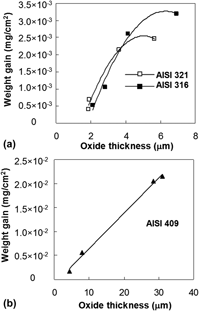Crossref Citations
This article has been cited by the following publications. This list is generated based on data provided by
Crossref.
R., Aadhavan
Bera, Parthasarathi
C., Anandan
S., Kannan
and
K., Suresh Babu
2017.
Phase evolution of EBPVD coated ceria-zirconia nanostructure and its impact on high temperature oxidation of AISI 304.
Corrosion Science,
Vol. 129,
Issue. ,
p.
115.
R., Aadhavan
and
K., Suresh Babu
2017.
Impact of structure and morphology of nanostructured ceria coating on AISI 304 oxidation kinetics.
Applied Surface Science,
Vol. 411,
Issue. ,
p.
219.
Aadhavan, R
Bhanuchandar, S
and
Babu, K Suresh
2018.
Surface coating of ceria nanostructures for high-temperature oxidation protection.
Materials Research Express,
Vol. 5,
Issue. 4,
p.
045025.
Liu, Qi
Xu, Hongxia
Yin, Huiqin
Li, Na
Wang, Wenrui
Li, Linfan
Tang, Zhongfeng
and
Qian, Yuan
2022.
Corrosion behaviour of 316 stainless steel in NaCl-KCl-MgCl2 salt vapour at 700°C.
Corrosion Science,
Vol. 194,
Issue. ,
p.
109921.
Zhang, Shengzan
Liu, Liyan
Ma, Xu
Zhu, Guorui
and
Tan, Wei
2022.
Effect of the third body layer formed at different temperature on fretting wear behavior of 316 stainless steel in the composite fretting motion of slip and impact.
Wear,
Vol. 492-493,
Issue. ,
p.
204220.
Hernández, Jesús D.
Onofri, Luca
and
Engell, Sebastian
2022.
Modeling and Energy Efficiency Analysis of the Steelmaking Process in an Electric Arc Furnace.
Metallurgical and Materials Transactions B,
Vol. 53,
Issue. 6,
p.
3413.
Hernández, Jesús D.
Onofri, Luca
and
Engell, Sebastian
2022.
Simulation and Optimization in Process Engineering.
p.
77.
Li, Jianna
Shao, Huiqi
Shao, Guangwei
Su, Chuanli
Yu, Qinghua
Huang, Yaoli
Chen, Nanliang
and
Jiang, Jinhua
2022.
Flexible Warp-Knitted Metal Mesh-Based Composites: An Effective EMI Shielding Material with Efficient Joule Heating.
ACS Applied Polymer Materials,
Vol. 4,
Issue. 10,
p.
7025.
Li, Wang
Feng, Zhihui
Gu, Jinbo
Cao, Zhu
Mu, Wangzhong
and
Li, Jingyuan
2022.
Partitioning behavior of N and its effect on hot deformation behavior of duplex stainless steels 2101 and 2205.
Journal of Materials Science,
Vol. 57,
Issue. 48,
p.
22119.
Zhao, Ting
He, Lijun
Qiu, Zhenghui
Zhang, Zhaoqi
and
Lin, Cunguo
2023.
Synergistic effect between sulfate-reducing bacteria and Shewanella algae on corrosion behavior of 321 stainless steel.
Journal of Materials Research and Technology,
Vol. 26,
Issue. ,
p.
4906.
Wen, Donghui
Jiang, BeiBei
Huang, Zhaowen
Kong, Fengyu
Jiang, Xionghua
Wang, Anding
Liu, Gang
and
Wang, Biao
2023.
Supersaturation and dissolvable α-Cr phase enable superior oxidation resistance in FeCrNi medium-entropy alloys.
Journal of Alloys and Compounds,
Vol. 954,
Issue. ,
p.
170216.
Zhu, En
Xia, Dianxiu
Chen, Peidun
Han, Qing
Wang, Xuelin
Liu, Zhiheng
and
Jiang, Kun
2023.
Study on the Effect of Niobium on the High Temperature Oxidation Resistance of Ferritic Stainless Steel.
Metals,
Vol. 14,
Issue. 1,
p.
25.
Zhang, Shengzan
Tian, Ce
Liu, Liyan
and
Tan, Wei
2023.
Effect of Temperature on Simulated Flow-Induced Vibration Wear Behavior of Inconel 690 Alloy Mated With 304 SS in Pressurized Steam/Water Environment.
Journal of Tribology,
Vol. 145,
Issue. 3,
Veile, Georg
Hirpara, Radhika
Lackmann, Simon
and
Weihe, Stefan
2024.
Investigation of Oxide Layer Development of X6CrNiNb18-10 Stainless Steel Exposed to High-Temperature Water.
Materials,
Vol. 17,
Issue. 18,
p.
4500.
Zou, Liang
Huang, Yang
Tan, Yun
Wang, Yueting
Wang, Tong
Ma, Yue
Yuan, Tiechui
and
Li, Ruidi
2025.
Anisotropy study of the microstructure, phase composition and properties of 321 stainless steel additively manufactured by laser powder bed fusion.
Journal of Manufacturing Processes,
Vol. 141,
Issue. ,
p.
1135.
Mugale, Manoj
Choudhari, Amit
Karki, Sanoj
Desai, Jay
Walunj, Ganesh
Vukkum, Venkata B.
Schwam, David
Gupta, Rajeev Kumar
and
Borkar, Tushar
2025.
Investigation of Protective Coatings for Reducing High-Temperature Oxidation of Steels.
JOM,
Vol. 77,
Issue. 2,
p.
653.
Bai, Jianfang
Li, Haijun
and
Wang, Guodong
2025.
Review on Evolution of Oxide Layer and Chromium Depletion Layer of Austenitic Stainless Steel during Industrial Processing.
steel research international,
Wang, Xiaolong
Ji, Zhiyun
Gan, Min
Fan, Xiaohui
Sun, Zengqing
Liu, Lincheng
Li, Jinhua
and
Yu, Dan
2025.
Deep understanding about the corrosion of grate bar in sintering flue gas: Chloride-induced function mechanism and mitigation strategy.
Engineering Failure Analysis,
Vol. 170,
Issue. ,
p.
109265.
